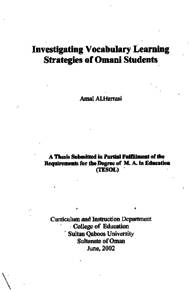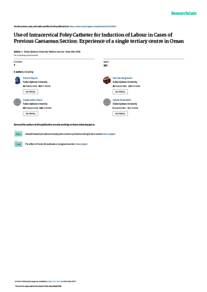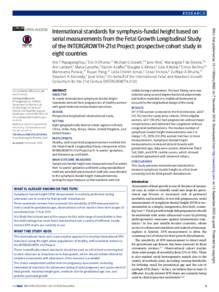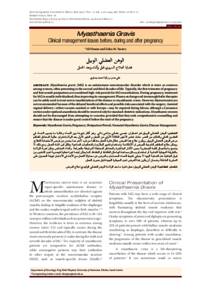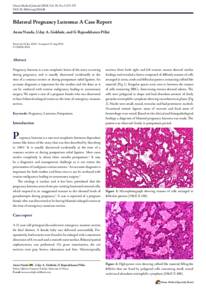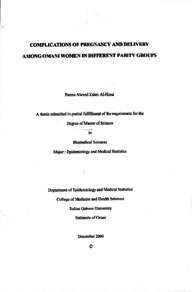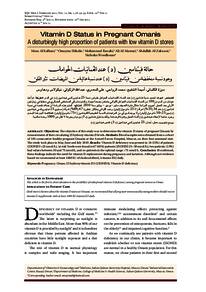Document
Third-trimester biomarkers as predictor for intra-uterine growth restriction in Omani women
Publisher
Sultan Qaboos University
Gregorian
2016
Language
English
English abstract
Background: Intrauterine growth restriction is a common complication of pregnancy which is associated with a variety of adverse perinatal complications including fetal morbidity and mortality, and its long-term consequences proceed into adulthood. A recent study has been conducted in SQUH which revealed an incidence rate of 6.86% for IUGR with high perinatal mortality rate among this group of 22 per 1000.
Aim: This study is proposed to find predictive markers that help in early identification and diagnosis of fetuses with growth restriction that may contribute to reduced adverse outcomes. Methods: The study evaluated maternal characteristics (age, pre-pregnancy weight, BMI, weight at 3rd trimester, gravidity and parity), ultrasound measures (amniotic fluid index AFI) and biochemical markers (fasting glucose, insulin, insulin resistance IR, lipid profile and placental growth factor PIGF). The study included a total of 117 pregnant Omani women (control, n=93, IUGR, n=24) with singleton gestation, and non-diabetic in their third trimester. Automated Cobas biochemistry analyzers were used to measure PIGF and insulin, glucose and lipid profile. All maternal details were obtained from a distributed questionnaire, and patient's medical records. Birth weight and baby's gender were recorded after delivery,
Results: Maternal parameters showed a strong positive correlation with the birth weight. Weight at 3rd trimester gave the highest correlation (r = 0.419 p < 0.001) followed by pre-pregnancy weight (r = 0.312 p = 0.001) then age, parity, weight gain, and gravidity respectively. Amniotic fluid index significantly correlated with birth weight as well following pre-pregnancy weight (r = 0.383 p < 0.001). The IUGR group had a significantly lower pre-pregnancy and 3rd trimester weight and parity. They also had lower weight gain and gravidity but results were not significant. As for biochemical parameters, glucose showed a significant negative correlation with birth weight (r = . 0.209 p = 0.024), The IUGR group showed lower values of placental growth factor PIGF, HDL and LDL that were not significant. Triglycerides however, were significantly lower in the IUGR group. In contrary, higher values for insulin and IR were found in the IUGR group. The main predictors of birth weight were: Pre-pregnancy weight 2- weight gain 3- IR 4- parity 5- PIGF. All together explained about 35.9% of the variation in birth weight. Interestingly, plasma PIGF and IR showed opposing trends, which also appeared in their association with birth weight.
Conclusion: Maternal characteristics play a major role in determination of birth weight. IUGR cases in this study were associated with younger maternal age and lower pre pregnancy and gestational weight in combination with low BMI and weight gain. These factors may increase the risk of having low birth weight infants compared to the controls. The relation of PIGF with insulin levels and hence insulin resistance may indicate an in inhibitory role of insulin on PIGF secretion which may explain the difference seen between the control and IUGR. These findings may contribute to the understanding of the role of growth factors in determining birth weight, which could be further investigated in early gestation in future studies.
Description
Thesis
Member of
Resource URL
Arabic abstract
خلفية : يعتبرتأخر نمو الجنين فالرحم من المشكلات المعقده و الذي يشير الى انخفاض وزن الجنين عن الوزن المتوقع بما يناسب عمر الحمل كما أنه يرتبط مع العديد من المضاعفات السلبية في فترة ما حول الولادة بما في ذلك معدلات الاعتلال والوفيات للأجنة، والتأثيرات على المدى الطويل والتي قد تمتد إلى مرحلة البلوغ. وقد أجريت دراسة حديثة في مستشفى جامعة السلطان قابوس SOUH كشفت عن معدل الإصابة 86.6% لتأخر النمو فالرحم مع ارتفاع معدل الوفيات في الوقت ما حول الولادة بين هذه المجموعة الى 22 في 1000. هدف الدراسة : تهدف هذه الدراسة إلى البحث عن المؤشرات الكيمائية التنبؤية التي تساعد في الكشف المبكر وتشخيص الأجنة بتأخر النمو فالرحم والتي قد تسهم في خفض النتائج السلبية. شملت الدراسة تقييم خصائص الأمهات (العمر، الوزن قبل الحمل، مؤشر كتلة الجسم، والوزن في الأشهر الثلاثة الأخيرة من الحمل ، عدد مرات الحمل ومعدل الولادات)، قراءات الموجات فوق الصوتية (مؤشر السائل الأمنيوسي AFI) والمؤشرات البيوكيميائية (جلوكوز , الأنسولين و مقاومة الأنسولين ، الدهون و عامل نمو المشيمة PIGF). وشملت الدراسة 117 من النساء العمانيات في الربع الثالث من الحمل (حمل بالوزن الطبيعي للجنين = 93، حمل مع تأخر نمو الجنين فالرحم، = 24) تم استبعاد الأمهات ذوات الأحمال المتعدده و المصابات بالسكري . استخدم جهاز کوباس لقياس PIGF والانسولين والجلوكوز والدهون. تم الحصول على كافة تفاصيل الأمهات من أستبيان وزع على كل المشاركات فالدراسة ، و من السجل الطبي لكل مشاركه . تم تسجيل الوزن وجنس الطفل بعد الولادة. النتائج : أظهرت خصائص الأمهات وجود علاقة إيجابية قوية مع وزن المولود عند الولادة. وزن الأم في الربع الثالث من الحمل أعطى أعلى ارتباط مع وزن المولود ( 0 . 001> r = 0 . 419 P)، يليه وزن الأم قبل الحمل ( 0 . 001> r = 0 . 312 P) ثم عمر الأم، عدد مرات الحمل، زيادة الوزن، ومعدل الولادات على التوالي. مؤشر السائل الأمنيوسي أيضا أظهر علاقه قويه مع الوزن عند الولادة ( 0 . 001> r = 0 . 383 P) وكذلك وزن الأم قبل الحمل. بالنسبه لخصائص الأمهات أظهرت مجموعه تأخر النمو فالرحم نتائج أقل بكثير لوزن الأم قبل الحمل وفي الربع الثالث من الحمل ومعدل الولادات. كما أظهرت أيضا هذه المجموعة معدلات أقل لزيادة الوزن وعدد مرات الحمل لكن لم يكن هناك فرق كبير ذا دلالة إحصائية. أما بالنسبة لمؤشرات الكيمياء الحيوية، أظهر الجلوكوز ارتباط سلبي كبير مع الوزن عند الولادة ( 0 . 024 = r = - 0 . 209 P وأظهرت مجموعة تأخر النمو فالرحم قيم أقل من عامل نمو المشيمة HDL LDL PIGF الدهون الثلاثية ، كانت أقل من ذلك بكثير في مجموعة تأخر النمو فالرحم على العكس من ذلك، تم العثور على قيم أعلى للأنسولين ومقاومه اللأنسولين في هذه المجموعة. كانت المتنبئات الرئيسية لوزن الطفل عند الولادة :1- وزن الأم قبل الحمل الوزن 2- زيادة الوزن 3- مقاومة الأنسولين 4- معدل الولادات 5- PIGF. العوامل الخمسه معا تشكل نحو ٪35 . 9 من التباين في الوزن عند الولادة. ومن المثير للاهتمام، أظهرت البلازما PIGF ومقاومة الأنسولين الاتجاهات المتعارضة، والتي ظهرت أيضا في ارتباطهم بالوزن عند الولادة. الخلاصة : خصائص الأمهات تلعب دورا رئيسيا في تحديد الوزن عند الولادة. وارتبطت حالات تأخر النمو فالرحم في هذه الدراسة مع الأمهات الأصغر عمرا وأقل فالوزن قبل الحمل وأثناء الحمل مع انخفاض مؤشر كتلة الجسم وانخفاض اكتساب الوزن خلال فترة الحمل. هذه العوامل قد تزيد من خطر احتمالية انخفاض الوزن عند الولادة مقارنة مع الضوابط علاقة PIGF مع مستويات الأنسولين، وبالتالي مقاومة الأنسولين قد تشير إلى وجود دور للأنسولين في التأثير على إفراز PIGF. يمكن أن تسهم هذه النتائج في فهم دور عوامل النمو في تحديد الوزن عند الولادة، والتي يمكن مواصلة البحث فيها في مراحل مبكرة من الحمل في الدراسات المستقبلية.
Category
Theses and Dissertations

